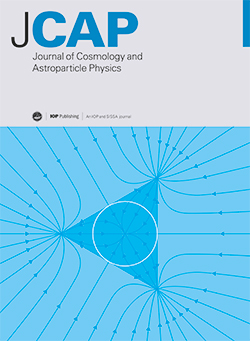Dynamics of the response of dark matter halo to galaxy evolution in IllustrisTNG
IF 5.3
2区 物理与天体物理
Q1 ASTRONOMY & ASTROPHYSICS
Journal of Cosmology and Astroparticle Physics
Pub Date : 2025-02-04
DOI:10.1088/1475-7516/2025/02/006
引用次数: 0
Abstract
We present the dynamical evolution of the dark matter's relaxation response to galaxies and their connection to the astrophysical properties as simulated in the IllustrisTNG suite of cosmological hydrodynamical simulations. Our results show that the radially-dependent linear relaxation relation model from our previous work is applicable at least from redshift z=5. We focus on the offset parameter q0, which characterizes the relaxation of dark matter shells without changing the enclosed mass. We perform multiple time-series analyses to determine the possible causal connections between the relaxation mechanism and astrophysical processes such as star formation and associated feedback processes, as well as feedback due to active galactic nuclei. We show that star formation activity significantly influences the halo relaxation response throughout its evolutionary history, with essentially immediate effects in the inner haloes and delayed effects of 2 to 3 Gyr in the outer regions. Metal content shows a weaker connection to relaxation than star formation rates, but the accumulated wind from feedback processes exhibits a stronger correlation. These findings enhance our understanding of halo relaxation mechanisms. Our estimates of the time-scales relevant for dark matter relaxation can potentially improve the description of halo profiles in existing baryonification schemes and semi-analytical galaxy formation models. Our results also show how the relaxation response of dark haloes can probe the evolutionary history of the galaxies they host.求助全文
约1分钟内获得全文
求助全文
来源期刊

Journal of Cosmology and Astroparticle Physics
地学天文-天文与天体物理
CiteScore
10.20
自引率
23.40%
发文量
632
审稿时长
1 months
期刊介绍:
Journal of Cosmology and Astroparticle Physics (JCAP) encompasses theoretical, observational and experimental areas as well as computation and simulation. The journal covers the latest developments in the theory of all fundamental interactions and their cosmological implications (e.g. M-theory and cosmology, brane cosmology). JCAP''s coverage also includes topics such as formation, dynamics and clustering of galaxies, pre-galactic star formation, x-ray astronomy, radio astronomy, gravitational lensing, active galactic nuclei, intergalactic and interstellar matter.
 求助内容:
求助内容: 应助结果提醒方式:
应助结果提醒方式:


